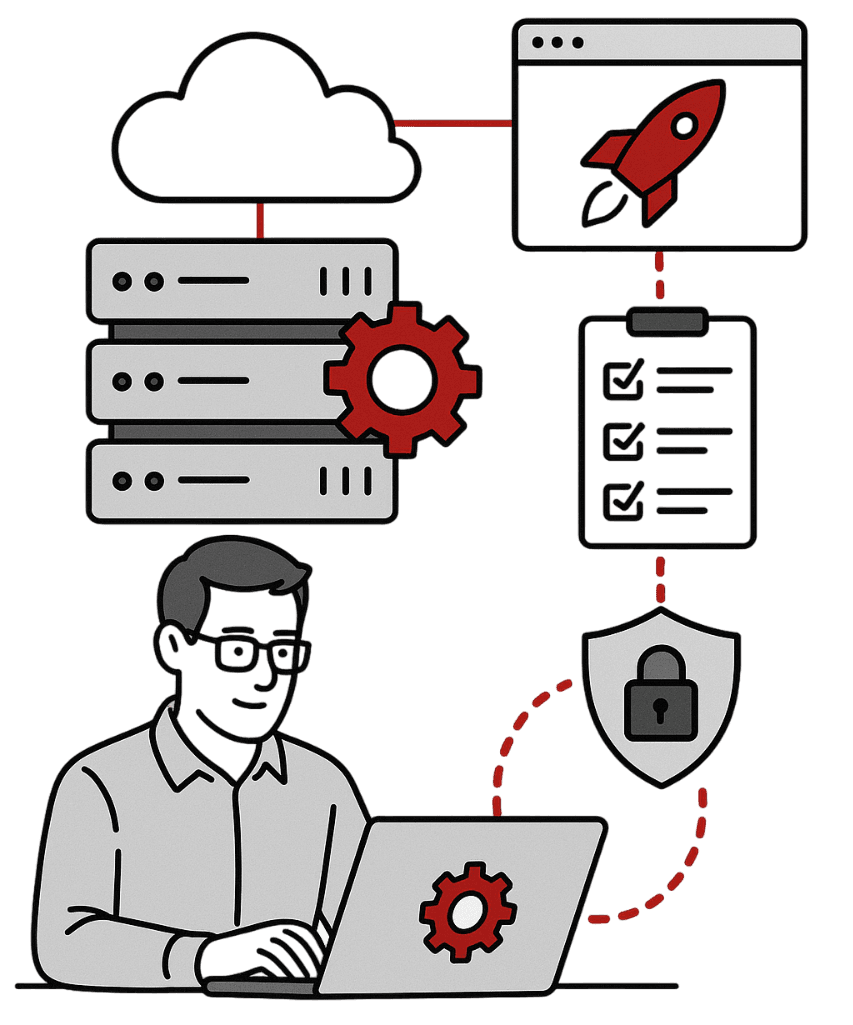
IT Automation Specialist
Transform Your IT Operations
- Provision infrastructure in secondsInstantly spin up AWS, Azure or GCP environments with Infrastructure-as-Code (Terraform, Ansible)—no more manual VM creation or “it worked on my machine” debates.
- Deploy applications automaticallyCI/CD pipelines (Jenkins, GitHub Actions, GitLab CI) deliver code to production without human intervention—zero manual steps, zero deployment drift.
- Reduce incidents & mean time to recoveryAutomated patch management, config enforcement and rollback scripts mean fewer surprises, faster fixes and far fewer all-nighters.
- Maintain compliance & security at scaleEnforce consistent security baselines (SELinux, Firewall rules, IAM policies) across hundreds of servers—always audit-ready and always up to date.
- Free your team to innovateEliminate repetitive server builds, manual config drifts and deployment headaches so SREs, DevOps and SysAdmins can focus on building features, not babysitting clusters.

(Picture a new staging environment standing up automatically whenever a feature branch is created—and 100% identical to production.)
How We Automate Your IT Stack

Discovery & Audit (Day 1–4)
- We review your current lead-capture methods (forms, landing pages, pop-ups) and tracking setup (GTM tags, GA4 events).
- We sketch a simple flowchart: Form Submission → Webhook → Zapier/n8n → CRM & Google Sheets → Dashboard Update

Design & Prototype (Day 5–10)
- Build prototypes using Google Tag Manager and webhooks to push form events into n8n or Zapier.
- Create a proof-of-concept: “Contact form → CRM (HubSpot/ActiveCampaign) → Slack notification → add to drip email.”
- Draft the blueprint for daily ad-performance syncs: “Google Ads API → n8n → Google Sheets → Looker Studio.”

Build & Test Workflows (Day 11–16)
- Configure GTM to fire custom events (button clicks, video plays, form submissions) and send them via webhook to n8n/Zapier.
- Develop n8n/Zapier pipelines that:
- Ingest events → transform payload (JSON→CSV)
- Push data into your CRM or email automation platform
- Update a Google Sheet or database table for reporting
- Set up daily/weekly pulls from Facebook Ads, Google Ads, LinkedIn Campaign Manager and GA4 into a centralized Google Sheet or BigQuery dataset.
- Test every trigger and action: verify that a form fill creates a CRM contact, triggers the right email sequence, and logs data in your dashboard.

Deploy & Monitor (Day 17–22)
- Publish GTM changes to production: all tags, triggers and variables go live.
- Turn on n8n/Zapier workflows with proper authentication (OAuth, API keys).
- Create a simple Looker Studio (Data Studio) dashboard that displays:
- New leads per channel
- Conversion rates (form submissions / page views)
- Ad spend vs. leads generated
- Engagement events (video views, button clicks, scroll depth)
- New leads per channel
- Configure real-time alerts (Slack or email) for critical thresholds: e.g., “Form error > 5% over last hour,” “Spend > budget,” “UTM break in tracking.”

Optimize & Scale (Ongoing)
- Weekly sprint: add new form sources (Typeform, JotForm, Calendly), refine event triggers (scroll depth, video percent watched), and build new ad-platform connectors.
- Provide “how-to” guides and exported workflow files (n8n JSON, Zapier templates, GTM container) so your in-house team can clone or adjust automations.
- Monthly performance report—delivered to Slack/email—showing:
- Time saved on data tasks
- Reduction in manual reporting errors
- Funnel performance metrics from first touch to conversion
- Time saved on data tasks

STEP 1
Discovery & Environment Audit (Day 1–5)
We inventory your current infrastructure: cloud accounts (AWS, Azure, GCP), on-prem clusters (VMware, Hyper-V), container platforms (Kubernetes, Docker Swarm).
We map manual processes: “Who provisions servers? Who writes firewall rules? How do you deploy new code?” Then we draft a simple flowchart:
Git commit → CI pipeline triggers → build artifact → deploy to staging → automated tests → deploy to prod

Step 2
Design & Prototype (Day 6–12)
We craft Infrastructure-as-Code templates (Terraform modules, Ansible playbooks) to automate server provisioning, network configuration and storage allocation.
We design CI/CD pipeline blueprints (Jenkinsfile, GitHub Actions YAML) to package, test and deploy applications automatically—no guesswork.
We create a proof-of-concept: a sandbox environment that spins up a complete stack (web server, database, load balancer) in minutes.

STEP 3
Build & Test Automation (Day 13–18)
We implement IaC in Terraform & Ansible:
- Cloud resources (VPCs, subnets, security groups, IAM roles)
- VM/Container configurations (EC2 or AKS/EKS clusters, Helm charts, Dockerfiles)
We configure CI/CD pipelines:
- Jenkins pipelines or GitHub Actions workflows to build, test and deploy containers.
- Automated rollbacks on test failures.
We integrate monitoring hooks (Datadog, Prometheus, ELK Stack) to collect metrics and logs from day one.

STEP 4
Deploy & Monitor (Day 19–25)
All workflows go live:
- Terraform applies create production, staging and dev environments automatically.
- Jenkins or GitHub Actions trigger on every push to main, running unit tests, integration tests and blue/green deployments.
- Automated patch management scripts run nightly to keep OS and packages up to date without manual SSH.
We provide a centralized dashboard (Looker Studio or Grafana) showing:
- Infrastructure drift (configuration vs. code)
- Deployment success rates and failure alerts
- Incident response times (MTTR) and uptime metrics

STEP 5
Optimize & Scale (Ongoing)
Weekly sprints: add new IaC modules (databases, caching layers), refine pipeline stages (security scans, performance tests) and tune auto-scaling rules.
We hand off “how-to” guides, Terraform state files, Ansible playbooks and Jenkinsfile/GitHub Actions YAML so your SREs can iterate.
Monthly performance report delivered to Slack/email: deployment frequency, lead time for changes, MTTR, cost optimization opportunities.
4
Hiring & Onboarding
Validate profiles, sign agreements, and onboard staff.
5
Ongoing Management & Billing
We handle payroll, benefits, and performance tracking while you focus on outcomes.
6
Deployment
An email containing details about the staff and supervisor assigned to your project will be sent to you.
1
STEP 1: Discovery & Environment Audit (Day 1–5)
- We inventory your current infrastructure: cloud accounts (AWS, Azure, GCP), on-prem clusters (VMware, Hyper-V), container platforms (Kubernetes, Docker Swarm).
- We map manual processes: “Who provisions servers? Who writes firewall rules? How do you deploy new code?” Then we draft a simple flowchart: Git commit → CI pipeline triggers → build artifact → deploy to staging → automated tests → deploy to prod
2
STEP 2: Design & Prototype (Day 6–12)
- We craft Infrastructure-as-Code templates (Terraform modules, Ansible playbooks) to automate server provisioning, network configuration and storage allocation.
- We design CI/CD pipeline blueprints (Jenkinsfile, GitHub Actions YAML) to package, test and deploy applications automatically—no guesswork.
- We create a proof-of-concept: a sandbox environment that spins up a complete stack (web server, database, load balancer) in minutes.
3
STEP 3: Build & Test Automation (Day 13–18)
- We implement IaC in Terraform & Ansible:
- Cloud resources (VPCs, subnets, security groups, IAM roles)
- VM/Container configurations (EC2 or AKS/EKS clusters, Helm charts, Dockerfiles)
- We configure CI/CD pipelines:
- Jenkins pipelines or GitHub Actions workflows to build, test and deploy containers.
- Automated rollbacks on test failures.
- We integrate monitoring hooks (Datadog, Prometheus, ELK Stack) to collect metrics and logs from day one.
4
STEP 4: Deploy & Monitor (Day 19–25)
- All workflows go live:
- Terraform applies create production, staging and dev environments automatically.
- Jenkins or GitHub Actions trigger on every push to main, running unit tests, integration tests and blue/green deployments.
- Automated patch management scripts run nightly to keep OS and packages up to date without manual SSH.
- We provide a centralized dashboard (Looker Studio or Grafana) showing:
- Infrastructure drift (configuration vs. code)
- Deployment success rates and failure alerts
- Incident response times (MTTR) and uptime metrics
5
STEP 5: Optimize & Scale (Ongoing)
- Weekly sprints: add new IaC modules (databases, caching layers), refine pipeline stages (security scans, performance tests) and tune auto-scaling rules.
- We hand off “how-to” guides, Terraform state files, Ansible playbooks and Jenkinsfile/GitHub Actions YAML so your SREs can iterate.
- Monthly performance report delivered to Slack/email: deployment frequency, lead time for changes, MTTR, cost optimization opportunities.
Real-World Success Stories

SaaS Platform
Before: Engineers spent 20+ hours/week manually provisioning VMs, applying patches and troubleshooting “works on dev” issues.
After: Terraform spun up dev/stage/prod environments in under 5 minutes; Jenkins pipelines delivered builds automatically.
Result: Deployment frequency increased from once/week to 5× per day; MTTR dropped 70%; Ops team reclaimed 15 hrs/week.

E-commerce Retailer
Before: Weekly patch cycles required manual SSH’ing into 50+ servers; patch windows caused downtime and compliance headaches.
After: Ansible playbooks automated security updates every night with zero intervention; automated rollback on any failed patch.
Result: Zero downtime during patch windows; compliance audit passed 100% on first try; Ops overhead reduced by 80%.

Enterprise Financial Services
Before: Multi-region Kubernetes clusters required manual helm chart updates and node scaling; incidents took hours to resolve.
After: GitOps with Argo CD triggered automatic cluster syncs; automated health checks and auto-healing ensured self-recovering pods.
Result: Incident rate dropped by 60%; cluster provisioning time fell from 3 hours to 10 minutes; teams moved to innovate rather than triage.
- E-commerce Brand–Before: 20 hrs/month manually tracking orders across platforms → After: Fully automated with Zapier, saving 20 hrs in Month 1, allowing the team to focus on email campaigns that boosted sales 15 %.
- Marketing Agency– Before: Errors in spreadsheets led to late invoices and six-figure revenue leakage → After: n8n workflows synced client details flawlessly, cutting invoice errors by 90 % and saving an average of 25 hrs/month.
- SMB Operations Team– Before: Nightly manual CSV exports to Excel for CFO review → After: Power Automate runs every evening, delivering clean reports by 6 AM—no more midnight spreadsheet stress.
(Detailed metrics and dashboards available upon request.)
Typical Deliverables
Terraform & Ansible IaC Modules
Reusable modules for VPCs, subnets, security groups, EC2/EKS/AKS clusters, database instances, load balancers.
CI/CD Pipelines
Jenkinsfiles or GitHub Actions YAML workflows for building, testing, containerizing and deploying apps.
Configuration Management Playbooks
Ansible playbooks to configure OS hardening, package installation and service orchestration.
Monitoring & Alerting Dashboards
Grafana, Datadog or Looker Studio dashboards tracking infrastructure drift, error rates, CPU/memory usage, and MTTR.
Execution Logs & State Files
Terraform state files, Ansible run logs, Jenkins build logs, plus centralized log aggregation (ELK or CloudWatch).
Flowcharts & Automations Guide
Visual BPMN-style diagrams showing each stage (provision → deploy → test → monitor) and step-by-step runbooks.
How-To Documentation
Step-by-step guides for your team to update IaC modules, add new microservices to the pipeline, and troubleshoot common issues.
Frequently Asked Questions
Which infrastructure-as-code tools do you specialize in?
We build and manage Terraform modules (AWS, Azure, GCP), Ansible playbooks (Linux, Windows), and Helm charts for Kubernetes—covering both cloud and on-prem environments.
Do you automate CI/CD for containerized applications?
Absolutely. We configure Jenkins pipelines or GitHub Actions workflows to build Docker images, run tests, push to container registries, and deploy to Kubernetes (EKS/AKS/GKE) or Docker Swarm clusters.
How do you manage state and prevent drift?
We use Terraform remote state backends (S3, Azure Blob, GCS) with locking (DynamoDB, Redis) and run nightly drift detection jobs. If drift is detected, Ansible or Terraform can re-apply the correct configuration automatically.
Can you automate patch management?
Yes—Ansible playbooks can run scheduled patch tasks (yum, apt, Windows Update) across thousands of servers, with built-in rollback on failure and compliance reporting.
What logging and monitoring platforms do you integrate?
We integrate Datadog, Prometheus/Grafana, ELK Stack (Elasticsearch, Logstash, Kibana) or native cloud tools (CloudWatch, Azure Monitor, Stackdriver) for centralized metrics and logs.
How do you ensure security & compliance?
We enforce security baselines (SELinux, firewall rules, IAM policies) via Ansible, implement secret management (Vault, AWS Secrets Manager), and automate compliance scans (OpenSCAP, CIS Benchmarks).
Can you handle hybrid cloud or multi-cloud environments?
Yes. Our Terraform modules are designed to be cloud-agnostic, so you can deploy identical stacks on AWS, Azure or GCP and even extend to on-premise VMware or OpenStack.
How long does onboarding take?
Typically 3–4 weeks:
- Day 1–5: Kickoff & infrastructure audit
- Day 6–12: Design & prototype IaC modules and pipelines
- Day 13–18: Build, test and refine automations
- Day 19–25: Deploy to production and set up monitoring
- Day 1–5: Kickoff & infrastructure audit
What is the ROI timeline?
Most clients see significant time savings (10–20 hours/week) within the first month, with full ROI—fewer incidents, faster deployments and reduced cloud spend—achieved by month two or three.
Do you provide training for our DevOps/SRE team?
Yes. We include “how-to” guides, hands-on workshops and documentation so your team can maintain, extend and troubleshoot the automations going forward.
Ready to Revolutionize Your Infrastructure?
Get your free IT automation audit
Contact Us Today!
About Us
PrimeOutsourcing is a Philippine-based offshore staff leasing provider, involved in the BPO, IT consulting, and outsourcing industries. Our main objective is to continually provide the best business solutions to improve our client’s productivity and achieve success.
Benefits
- No Hidden Charges
- Affordable Rates
- Customized Plans
- Dedicated Staff
- No Set-up Fee
Why Choose Us?
- Lower your overhead cost by turning over staff management to us.
- Get flexible staffing solutions at comparatively lower rates.